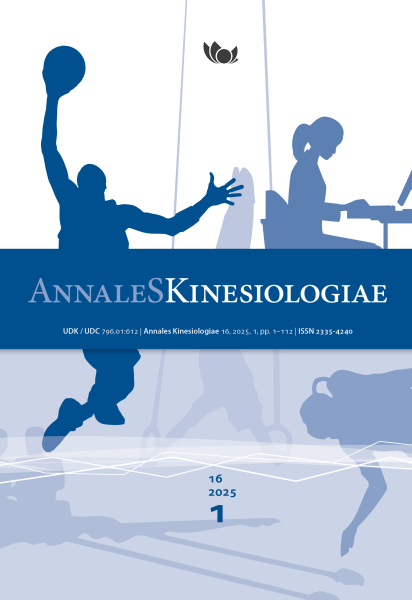The effect of booster breaks on non-specific low back pain in office workers
DOI:
https://doi.org/10.35469/ak.2025.498Keywords:
non-specific low back pain, ergonomics, booster breaks, prolonged sitting, office workersAbstract
Purpose: Prolonged sitting has a negative effect on office workers, and non-specific low back pain (NSLBP) is one of the most common consequences of an inactive lifestyle and prolonged sitting. Active breaks are a promising intervention to reduce the negative effects of office work.
Methods: Forty-two office workers from a Slovenian company were divided into an experimental group (24 office workers who had been taking active breaks for one and a half years) and a control group (N=18, no active breaks). The participants were not randomly allocated to the groups; allocation was based on availability and voluntary participation.
An online survey was conducted using the Oswestry Disability Index 2.0 (ODI 2.0) and the Visual Analog Scale (VAS). This was a non-randomized, two-arm longitudinal study. Questionnaires were administered once, 1.5 years after the intervention. Statistical analyses were conducted using the Mann-Whitney and Wilcoxon signed-rank tests, with the level of significance set at p ≤ 0.05.
Results: The results showed that 81% of office workers had experienced NSLBP at least once in their lives. The ODI 2.0 scores were not significantly lower in the experimental group (p = 0.155). However, pain intensity was lower in office workers who took active breaks (p = 0.001). All the participants in the experimental group reported that active breaks had a positive effect on their well-being (100%). Furthermore, 37.5% of the participants stated that they had become more physically active outside the office as a result of the active breaks.
Conclusion: Introducing active breaks into the daily routine of office workers is a viable and effective intervention to mitigate the risk of NSLBP. Active breaks offer a comprehensive solution: they not only reduce the negative effects of prolonged sitting, but also reduce stress, improve work efficiency and focus, and promote better moods.
Downloads
References
Agarwal, S., Steinmaus, C., & Harris-Adamson, C. (2018). Sit-stand workstations and impact on low back discomfort: a systematic review and meta-analysis. Ergonomics, 61(4), 538-552. https://doi.org/10.1080/00140139.2017.1402960
Balci, R., & Aghazadeh, F. (2004). Effects of exercise breaks on performance, muscular load, and perceived discomfort in data entry and cognitive tasks. Computers & Industrial Engineering, 46(3), 399–411. https://doi.org/10.1016/j.cie.2004.01.003
Bekkering, G. E., Hendriks, H. J. M., Koes, B. W., Oostendorp, R. A. B., Ostelo, R. W. J. G., Thomassen, J. M. C. & van Tulder, M. W. (2003). Dutch physiotherapy guidelines for low back pain. Physiotherapy, 89(2), 82–96. https://doi.org/10.1016/S0031-9406(05)60579-2
Hagen, K. B., Hilde, G., Jamtvedt, G. & Winemm, M. F. (2000). The Cochrane review of bed rest for acute low back pain and sciatica. Spine, 25(22). 2932–2939. https://doi.org/10.1097/00007632-200011150-00016
Jakovljević, M., & Puh, U. (2014). Ocenjevanje intenzivnosti bolečine z vidno analogno lestvico [Pain intensity assessment using visual analogue scale]. Fizioterapija, 22(2), 46–55. Retrieved from https://physio.si/wp-content/uploads/2021/05/7.-22-2-Ocenjevanje-intenzivnosti-bolecine.pdf
Kim, T. Y., Lee, J. H., Oh, S. J., Kim, S. & Yoon, B. C. (2019). Effectiveness of simulated horseback riding for chronic low back pain patients: A randomized controlled trial. Journal of Sport Rehabilitation, 29(2), 179–185. https://doi.org/10.1123/jsr.2018-0252
Klemenc-Ketiš, Z. (2011). Disability in patients with chronic non.specific low back pain: validation of the Slovene version of the Oswestry Disability Index. Slovenian Journal of Public Health, 50(2), 87–94. https://doi.org/10.2478/v10152-010-0031-8
Koren, K., Pišot, R., & Šimunič, B. (2016). Active workstation allows office workers to work efficiently while sitting and exercising moderately. Applied ergonomics, 54, 83-89. https://doi.org/10.1016/j.apergo.2015.11.013
Marusic, U., Müller, M. L., Alexander, N. B., & Bohnen, N. I. (2020). Feasibility and behavioral effects of prolonged static and dynamic standing as compared to sitting in older adults with type 2 diabetes mellitus. BMC geriatrics, 20(1), 1-8. https://doi.org/10.1186/s12877-020-01600-0
Physiopedia. (2021). Oswestry Disability Index. Physiopedia. Retrieved from https://www.physio-pedia.com/Oswestry_Disability_Index#cite_note-4
Šömen, M. M., Peskar, M., Wollesen, B., Gramann, K., & Marusic, U. (2023). Does standing up enhance performance on the stroop task in healthy young adults? A systematic review and meta-analysis. International journal of environmental research and public health, 20(3), 2319. https://doi.org/10.3390/ijerph20032319
Taylor, W. C. (2005). Transforming work breaks to promote health. American Journal of Preventive Medicine, 29(5), 461–465. https://doi.org/10.1016/j.amepre.2005.08.040
Tidy, C. (2020). Lower back pain. Patient. Retrieved from https://patient.info/bones-joints-muscles/back-and-spine-pain/lower-back-pain
Van Emde Boas, M., Pongmala, C., Biddix, A. M., Griggs, A., Luker, A. T., Carli, G., ... & Bohnen, N. I. (2024). Post-physical therapy 4-month in-home dynamic standing protocol maintains physical therapy gains and improves mobility, balance confidence, fear of falling and quality of life in Parkinson’s Disease: A randomized controlled examiner-blinded feasibility clinical trial. Journal of Frailty, Sarcopenia and Falls, 9(4), 267–280. https://doi.org/10.22540/JFSF-09-267
Van Tulder, M., Malmivaara , A., Esmail, R. & Koes, B. (2000). Exercise therapy for low back pain: a systematic review within the framework of the cochrane collaboration back review group. Spine, 25(21), 2784–2796. https://doi.org/10.1097/00007632-200011010-00011
Waddell, G., Feder, G. & Lewis, M. (1997). Systematic reviews of bed rest and advice to stay active for acute low back pain. British journal of general practice : the journal of the Royal College of General Practitioners, 47(423), 647–652. https://pubmed.ncbi.nlm.nih.gov/9474831/
Waongenngarm, P., Areerak, K. & Janwantanakul, P. (2018). The effects of breaks on low back pain, discomfort, and work productivity in office workers: A systematic review of randomized and non-randomized controlled trials. Applied Ergonomics, 68, 230–239. https://doi.org/10.1016/j.apergo.2017.12.003
Downloads
Published
How to Cite
Issue
Section
License
Copyright (c) 2025 Uroš Marušič, Tajda Uršič

This work is licensed under a Creative Commons Attribution 4.0 International License.
Open Access Policy and Copyright
This journal provides immediate open access to its content on the principle that making research freely available to the public supports a greater global exchange of knowledge. Users are allowed to read, download, copy, distribute, print, search, or link to the full texts of the articles, or use them for any other lawful purpose, without asking prior permission from the publisher or the author.
Authors who publish with this journal agree to the following terms:
- Authors retain copyright and grant the journal right of first publication with the work simultaneously licensed under the terms of the Creative Commons Attribution license (CC BY) that allows others to share the work with an acknowledgement of the work’s authorship and initial publication in this journal.
- Authors grant the publisher commercial rights to produce hardcopy volumes of the journal for sale to libraries and individuals.
- Authors are able to enter into separate, additional contractual arrangements for the non-exclusive distribution of the journal’s published version of the work (e.g., post it to an institutional repository or publish it in a book), with an acknowledgement of its initial publication in this journal.








